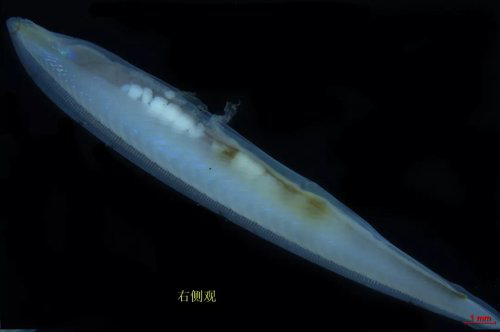From 2019 to 2020, Guangdong Nanpeng Islands Marine Ecology National Nature Reserve Management Bureau organized and cooperated with researchers from the Third Institute of Oceanography of the Ministry of Natural Resources to carry out a background survey on marine biodiversity conservation in the waters of Nanpeng Islands. There were two new findings on diversity.

Photo courtesy of the correspondent
Guangdong Nanpeng Islands National Nature Reserve is located on the vast sea where the northeastern end of the South China Sea meets the southwestern end of the Taiwan Strait. The geographical advantage is obvious, the hydrological and climatic conditions are unique, and the seabed topography is diverse.
During the survey of macrobenthos in the shallow seas in the waters around the Nanpen Islands, the national second-class protected animal, Epigonichthys cultellus Peters (1877), was rediscovered. Mr. Zhang Xi reported the short-dagger side colony in the waters of South Australia by Mr. Zhang Xi as early as 1962; in 1974, a specimen with a total length of 17.2mm and a body height of 2.0mm was obtained during the survey of fishery resources in southern Fujian; the survey of benthic organisms in the Taiwan Strait from 1984 to 1985 The samples were obtained in the comprehensive survey of the southern Taiwan Strait in 1986 and the sedimentary biological ecological survey in the East Guangdong Petroleum Development Zone, but they were not found in the surveys in 1989-1991 and 2008, so they were not recorded when the protected area was established. object of protection.
The short knife partial amphioxus is also called the short knife lateral amphibian, which belongs to the phylum Chordate, the subphylum of cephalopods, the class of narrow hearts, the family Amphiidae, and the genus of amphibians. It occupies an extremely important position in the study of origin and evolution, and is hailed as a "living fossil" by zoologists.
In this survey, among the 12 shallow sea macrobenthos survey stations, a total of 7 stations were found to be amphibians, with an occurrence rate of 58.33%, which was the first time to re-record in 35 years in the waters. Amphioxus has strict requirements on the environmental conditions of the habitat. Most of them live in the sea area with relatively gentle water flow, fresh water and rich plankton, and prefer sandy sedimentary areas. The re-emergence of Amphioxus serrata shows that the waters have suitable ecological conditions for Amphioxus lanceolata, which to a certain extent reflects the effectiveness of the construction of the Nanpeng Islands Reserve.
In August 2019, during the diving survey of the reef fishes around the Nam Peng Islands, four newly recorded species were found in the waters of the Nam Peng Islands, namely Abudefduf bengalensis and Amphiprion clarkii. , Choerodon azurio, and Arothron stellatus. These four kinds of fish belong to the reef fish distributed within 60 meters of water depth. Among them, the Bengal damselfly, the blue pigtooth and the double sawfish are more suitable for the waters with higher water temperature; the double sawfish (commonly known as the double sawfish) clownfish), hidden in the tentacles of sea anemones, and the density of some stations even reaches 20 fish/100㎡.
The discovery of these species in this sea area suggests from the side that the water temperature and reef environment of the surveyed waters are suitable for the distribution of these species, and even reveals that the reef environment composed of stony coral communities has a certain scale, which can support the survival and reproduction of a variety of coral reef fishes .
Source: Information Times